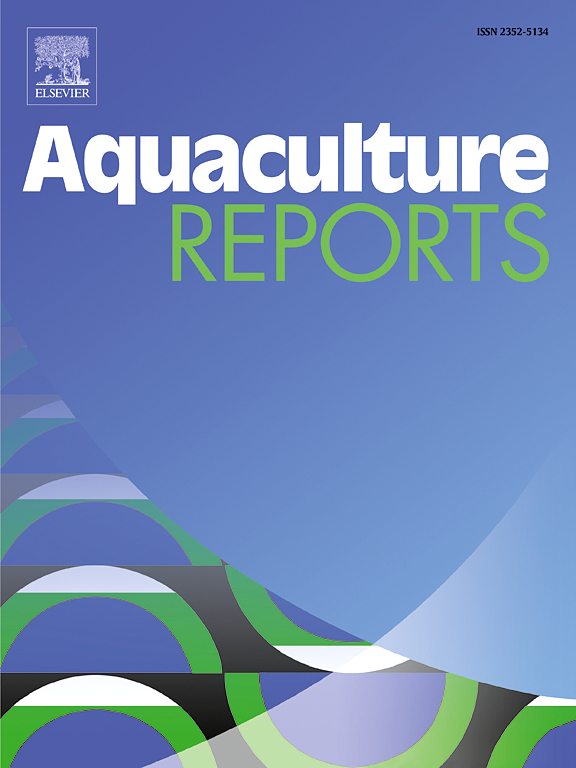Effect of background color on the growth performance, digestive enzyme activity, antioxidant capacity, and intestinal microbiota of juvenile Plectropomus leopardus
IF 3.2
2区 农林科学
Q1 FISHERIES
引用次数: 0
Abstract
The scale of Plectropomus leopardus breeding is continually expanding, and this has necessitated constant changes to ensure that breeding conditions are optimized. Background color is an important factor affecting fish feeding. In this study, fish (10.58 ± 0.03 g) were cultured on five background colors (red, blue, black, white, and transparent), and the growth status and intestinal microbes of these fish over 56 days were analyzed. Growth performance and the expression of growth-related genes were optimized when the background color was white. The white group had higher AMS and LPS enzyme activities and lower T-SOD and T-AOC enzyme activities, indicating that the white background could effectively promote feeding and reduce oxidative stress in P. leopardus. Additionally, changes in background color altered the composition and function of the intestinal microbiota. The diversity and abundance of intestinal microbiota, including the abundance of beneficial bacteria, were highest in fish on a white background. The abundances of Firmicutes and Actinobacteriota and the abundance of Bacillus were higher in the White group than in the other groups, indicating that a white background promotes the health of juvenile P. leopardus. In conclusion, a white background can promote the growth performance of P. leopardus and increase the abundance of beneficial intestinal microbes. Generally, the results of our study could be used to optimize the culture of P. leopardus.
背景颜色对幼豹的生长性能、消化酶活性、抗氧化能力和肠道微生物群的影响
豹纹鲤的养殖规模在不断扩大,这就需要不断改变,以确保养殖条件最优化。背景颜色是影响鱼类摄食的一个重要因素。本研究用五种背景颜色(红色、蓝色、黑色、白色和透明)养殖鱼类(10.58 ± 0.03 g),并分析了这些鱼类 56 天的生长状况和肠道微生物。当底色为白色时,生长性能和生长相关基因的表达均达到最佳状态。白色组的 AMS 和 LPS 酶活性较高,T-SOD 和 T-AOC 酶活性较低,这表明白色背景能有效促进豹纹鲤摄食和减少氧化应激。此外,背景颜色的变化还改变了肠道微生物群的组成和功能。白色背景下鱼类肠道微生物群的多样性和丰度(包括有益菌的丰度)最高。白色组的固着菌群和放线菌群的丰度以及芽孢杆菌的丰度均高于其他组,这表明白色背景能促进豹纹鲤幼鱼的健康。总之,白色背景可促进豹纹鲤的生长性能,并增加肠道有益微生物的数量。总体而言,我们的研究结果可用于优化豹纹鲤的培养。
本文章由计算机程序翻译,如有差异,请以英文原文为准。
求助全文
约1分钟内获得全文
求助全文
来源期刊

Aquaculture Reports
Agricultural and Biological Sciences-Animal Science and Zoology
CiteScore
5.90
自引率
8.10%
发文量
469
审稿时长
77 days
期刊介绍:
Aquaculture Reports will publish original research papers and reviews documenting outstanding science with a regional context and focus, answering the need for high quality information on novel species, systems and regions in emerging areas of aquaculture research and development, such as integrated multi-trophic aquaculture, urban aquaculture, ornamental, unfed aquaculture, offshore aquaculture and others. Papers having industry research as priority and encompassing product development research or current industry practice are encouraged.
 求助内容:
求助内容: 应助结果提醒方式:
应助结果提醒方式:


